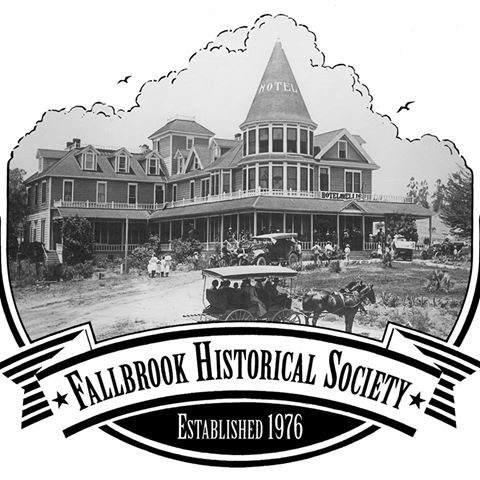The Palomares Ranch House is the last surviving structure of the historic Rancho Monserate that was settled by the Alvarado family in 1846. Today it is headquarters for the Fallbrook Land Conservancy.
Built about 1888, the Palomares House has major architectural significance as a rare example of the small vernacular structures that were the common style of rural folk farmhouses in San Diego County during the 19th century. Historic preservationists have tended to over emphasize saving eloquent and stylish buildings. This bias has facilitated the loss of many common or working-class structures, resulting in a false view of how most people lived a century ago.
In 1988, without any historic protection, the Palomares House was threatened with destruction to make room for a new housing subdivision. The Fallbrook Historical Society and the Fallbrook Land Conservancy worked with others to save the Palomares House.
The first map representation of the Palomares House was on an 1891 USGS government survey map. The Palomares Ranch House is occasionally referenced in Fallbrook Enterprise news accounts in the 1910s. The Palomares and the original barn associated with the house are visible in a 1928 aerial photograph. The barn has not survived.

Lugarda Alvarado and her two older siblings, Tomas and Dolores, the grandchildren of a Spanish soldier, were all born in Los Angeles, but they grew up on Rancho Monserate along the San Luis Rey River when the Alvarado family settled here in 1846, when California was still part of Mexico. After their parents died during the smallpox epidemic that swept North San Diego County in 1862-63, the three Alvarado children became heirs to the huge 13, 332-acre ranch. Lugarda’s inheritance was the north western third of Rancho Monserate, about 4,400 acres.
Lugarda Alvarado married Francisco Palomares, a childhood acquaintance of another prominent Californio family from Los Angeles. Lugarda and Francisco were married in January 1866 at the nearby Rancho Buena Vista.
The Palomares House is estimated to have been constructed about 1888 because it is not called out on earlier survey maps, but is shown on the above mentioned 1891 USGS survey. The square headed nails used to attach sheathing boards to the rafters indicate a pre-1890 date.
Some years after the death of her husband Francisco Palomares in 1882, Lugarda directed her son-in-law Henry Abila to build the Palomares House, and to be her trustee of the Monserate property. Henry Avila is said to have occasionally resided in Fallbrook when he made legal history by fighting the Fallbrook Irrigation District. Abila won the court case, on behalf of his mother-in-law, at the U.S. Supreme Court to have the Irrigation District declared invalid in 1896.
There is no evidence that the Palomares ever lived in this house, as it was not built until years after their marriage. Lugarda and Francisco Palomares were absentee landlords, living either in Los Angeles, or at his Rancho San Jose near today’s Pomona. However, there is speculation that Lugarda’s daughter and her husband Henry Avila may have stayed at the house about 1890 when the house was new (see below).
Title to the Rancho Monserate land finally cleared in 1874 when the final U.S. Geological Survey (USGS) of the Rancho was approved. Lugarda’s Tract “D” of the Rancho Monserate property was leased to various grain farmers, including Fallbrook’s Russell brothers.
With the recovery of her land, which had been briefly confiscated by the Irrigation District for tax delinquency, Lugarda formed the Palomares Land Company in 1896 and subdivided Tract “D” into 40 acre lots to lease or sale.
In 1903 the entire south half of Tract “D” was purchased by William Gird, a stock raiser and farmer. The remaking northern half of 2,341 acres, where the Palomares House stood on Lot 5, was purchased and resold by a series of speculators beginning in 1911. With the creeks that crossed the property, and its deep wells, the water rights here were considered extremely valuable. Black-eyed beans and alfalfa were some of the crops farmed here.
Mr. and Mrs. William Moore lived and farmed on the Palomares Ranch in 1914. In 1918, Mr. and Mrs. Gladding were ranch caretakers living in the Palomares ranch house. In 1924, John W. McCormac bought the property and planted citrus. Clarence and Myrtis Story, parents of Jack Story, purchased this ranch house and property in 1954. In 1964 the Palomares House and surrounding property was purchased by Victor and Virginia Hansen who planted and operated a large Christmas tree farm here for over 20 years.
Tom Frew,
FHS Historian
Acknowledgements:
Historical and Architectural Assessment of The Palomares Ranch House prepared for TMI Environmental Services, San Diego by Stephen R. Van Wormer, February 1988.
Report of Structural Investigation for Palomares Ranch Building prepared by HRC Consultants Inc, Pasadena by Richard A. Ranous, 1988.
Historical/Architectural Status of the Palomares Ranch Building, by Roger G. Hatheway of Hatheway & McKenna, May 7, 1988
Report on historic preservation in Fallbrook regarding the Hansen/Palomares case by Elizabeth Yamaguchi of the Fallbrook Historical Society, July 1988.
References:
Rancho Monserate, Fallbrook Historical Society Spring 2020 Historian.
Fallbrook Enterprise newspapers on file at the Fallbrook Historical Society.





